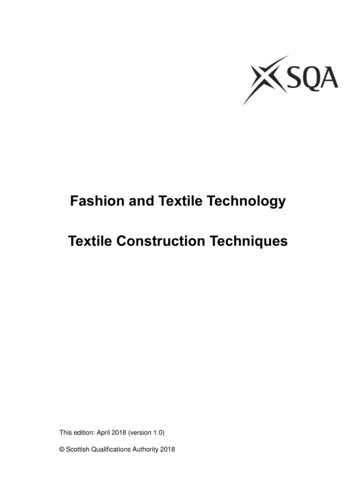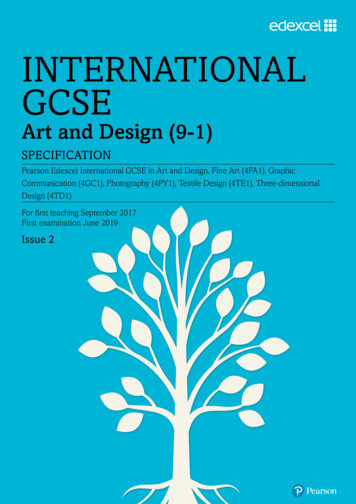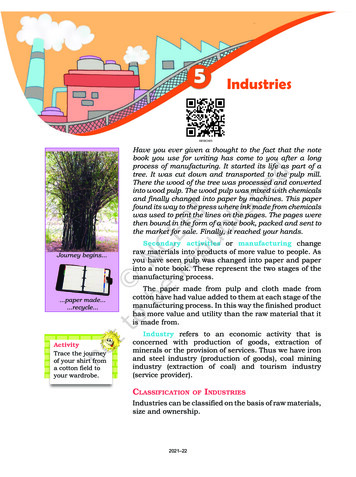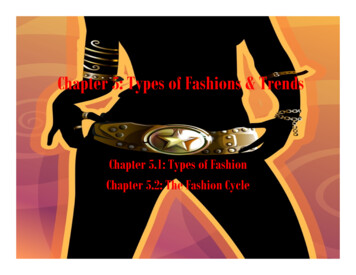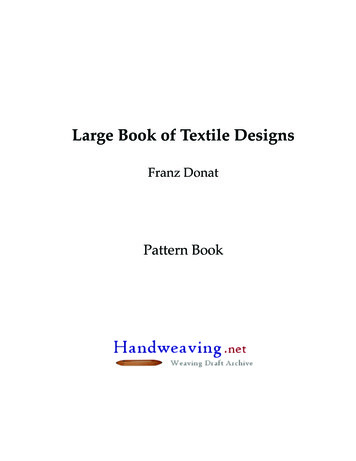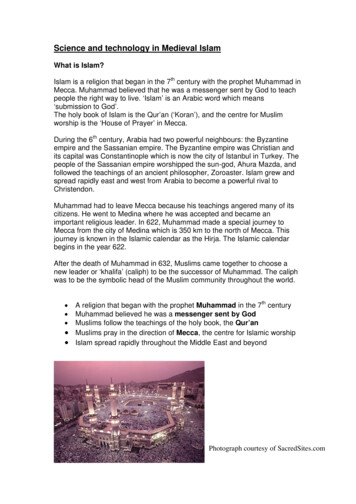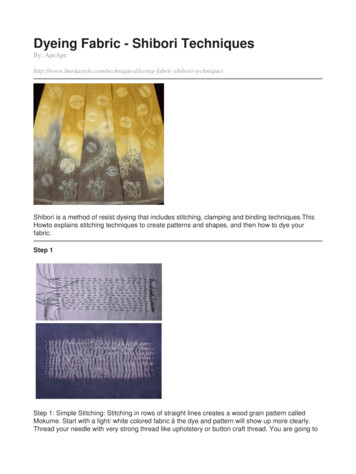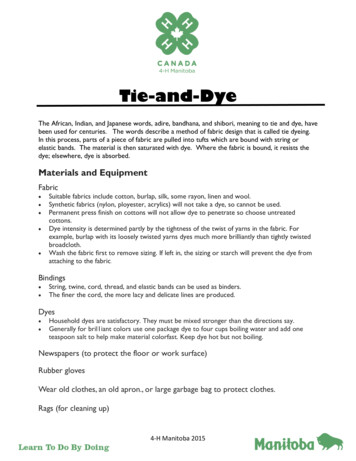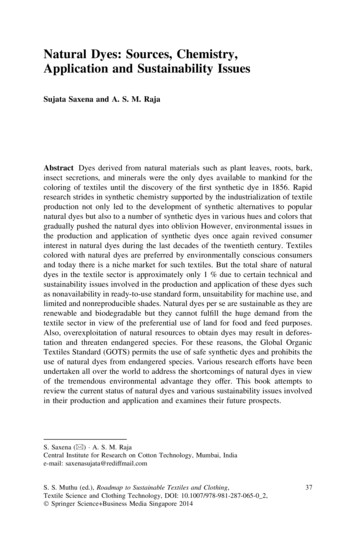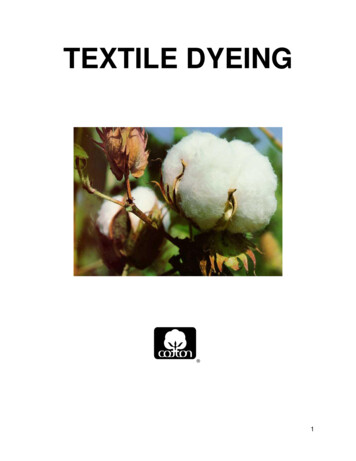
Transcription
TEXTILE DYEING 1
Textile Dyeing1.0 IntroductionColor is an extremely important aspect of modern textiles. The color of a textile productis a major factor in the marketing and use of that product. The color of textiles can beused to differentiate groups of people such as uniforms used for athletic teams, hospitalpersonnel or military organizations. Color can also be functional such as camouflage orprotective uniforms. However, in the modern retail store, the color of textile products is amajor contributor to what is referred to as fashion. The color is very important withapparel, carpet, upholstery, curtains, drapes, sheets and towels. All of the items aremarketed with an emphasis on their specific color.1.1 Textile ColorationDyeing is the application of color to a textile material with some degree of fastness orpermanence. The materials which impart the color are known as colorants. Whenthese colorants have a natural affinity and permanence on textiles, they are referred toas dyes. Dyes actually migrate or diffuse into the chemical molecular structure of textilefibers in order to develop the final color of the textile product. The dye-fiber molecularassociation is also responsible for the degree of fastness or permanence of the colorbecause of the molecular attraction between the specific dye and the specific textilefiber; dyes are classified as being fiber specific. That is, dyes which work on cotton willnot work on polyester, nylon, acrylic, wool and many other commonly used textile fibers.However, because the basic structure of cotton is cellulose, the dyes which work oncotton will also work on other cellulose based fibers such as linen, ramie, rayon andlyocell. It should be noted that the color actually produced on cotton by any single dyeor combination of dyes will not necessarily match the color produced when these samedyes are used on linen or ramie or rayon. Many unique factors contribute to the colorproduced by textile dyeing including fiber properties. This situation will be discussed inmore detail later in this document.The other colorant used on textile fibers are pigments. Pigments unlike dyes, have nonatural affinity for textile fibers. In order to produce permanent color on textile products,pigments are bound to the surface of the textile fibers using adhesives or glues whichare known as binders. There is a wide variety of binder systems available with variousproperties. Their specific advantages and limitations will be discussed later. However,it is important to note that pigment colorants have no permanence on textile fiberswithout using some type of binder system. Additionally, many of the binders work on2
many different types of fibers. Unlike dyes, pigments are not fiber specific. The samepigment binder combination can work on both cotton and polyester at the same time.Historically, textile dyeing predates written history. There is evidence that indigo andother plant based dyes were known and in use around 4000 BC. The modern countriessuch as Egypt, India, and China have archeological evidence of highly developedancient textile products and processes. Mixing of existing dyes to produce multipleshades in wide color gamut was a common practice over 2000 years ago.1.2 Natural DyesUntil 1856, all textiles used throughout the world were natural dyes. That is, these dyeswere obtained directly from the natural environment in one way or another. The vastmajority of the natural dyes came from either plants or animals. For example, a majordye discovered by the Aztec or Mayan Indians was ‘cochineal’. It is a relatively brightred that is obtained from the body of the cochineal insect. The insect must be crushedand the dye is refined from the remains of the insect. Reportedly, 70,000 insects arerequired to produce one pound of dye. Cochineal is still used today as a naturalcommercial product in both textile dyeing and in food coloring.Another natural animal dye which had a tremendous impact in the ancient world was‘Tyrian Purple’. This dye was discovered near the ancient city of Tyre, which is inLebanon. It was discovered that when a sea mollusk native to the Tyre coastal regionwas crushed and refined, an extremely bright purple dye was produced. This dyeexhibited very good fastness properties compared to other natural dyes. However, thisdye was also very rare and difficult to produce. It took approximately 12,000 seamollusks to produce one gram of dye. It should be noted that there are approximately454 grams in one pound. Because of the brightness and rarity, Tyrian Purple washighly prized but also extremely expensive. Only the wealthiest in society, such askings and queens, could afford this dye. From ancient times until today, the monarchiessurrounding the Mediterranean Sea have purple robes as part of the royal heritage.Today, the Tyrian Purple sea mollusk is extinct, but the dye can be made synthetically.The most well known and most used dye of all time is ‘indigo’. This dye is obtainedfrom the leaves, stems and beans of a variety of plants, including one variety known asthe indigo plant. In order to obtain the dye, the harvested plant matter is fermented overseveral weeks time. The dye itself is the major product of the fermentation process.Figure 1 shows the indigo plants and beans, as well as, the fermentation process.After fermentation, the water insoluble solid indigo is washed to remove impurities anddried. This results in a powdery solid dye. In order to dye textile fibers, especiallycotton, the indigo must be made water soluble by a chemical process known asreduction. The water soluble reduced indigo is rapidly absorbed by the cotton fibers.3
Once inside the fiber structure, oxygen in the air converts the indigo back to its original,water insoluble form, as is illustrated above.Figure 1 – Indigo The Old Way.Indigo Plant & BeansFermenting the IndigoOxidizing, Drying, and DyeingModern indigo dyeing will be discussed in more detail later in this document. Althoughindigo was known by many ancient groups, the art of indigo dyeing of textiles wasdeveloped by the ancient Chinese and Indian cultures. Indigo dyed cotton fabric wasone of the major items of trade which prompted Columbus and others to search for newand better trade routes to India in the 15th and 16th centuries. Today, the modern textileindustry uses synthetically produced indigo due to the high volume of dye required forcurrent denim production. The natural indigo dye is too cumbersome to produce andrequires enormous amounts of farm land. However, from the dyeing standpoint,synthetic indigo and naturally grown indigo are identical.4
1.3 Synthetic DyesIn 1856, Sir William Henry Perkin of England discovered the first synthetic dye, a purpleknown as ’mauveine’. His discovery not only revolutionized the textile dyeing industry,but it led to the development of the synthetic organic chemical industry. Indirectly,Perkin is responsible for modern medicines, plastics, paints, synthetic textile fibers, andmany other modern products. Compared to modern synthetic dyes, natural dyes havepoor color intensity and limited color durability. Also, these dyes can be very difficult toobtain, as well as cumbersome to apply to textile fibers. Additionally, many of thenatural dyes require metallic salts known as ‘mordants’ in order to produce someminimally acceptable degree of color fastness. Many of these mordants are very toxic.Because of this fact, and other reasons, the use of natural dyes can actually be moredamaging to the environment than the use of synthetic dyes. In terms of colorperformance and dyeing process control, synthetic dyes are fiber selective which, inpart, accounts for their superior properties. However, the overall color quality of thefinal product can be influenced by a number of factors including fiber type and quality,dye selection and quality, purity of process water and dyeing process control. These aswell as other factors will be discussed in this document.2.0 Preparation ProcessesThe quality of dyeing of any textile material is directly dependent on the quality of thetextile fibers used to manufacture the product. Moreover, to maximize dyeing processefficiency and color performance properties, the textile fibers involved must be as cleanas possible. The central goal of preparation is the removal of both naturally occurringimpurities and those which are added during yarn or fabric manufacturing. The dyeingprocess can be performed on textile fibers, yarns, fabrics or garments, depending onthe properties or for cost control. Preparation can also be performed at any processingstage depending on the dyeing technique employed. However, fabric preparation istypically most often used. Additionally, some commonly used optional preparationprocesses such as singeing or mercerization can only be performed on yarns or fabrics.Complete fiber cleanliness is not easily achieved. The degree of cleanliness of thetextile material is only determined by employing standard accepted testing methods andproperly interpreting the data obtained. However, not all shades require the samedegree of cleanliness to achieve high quality color performance. Deep, dark shades ofgreen, brown, blue and black do not require the ultimate fiber cleanliness needed bywhites, light pastel and bright medium colors. Regardless, the often quoted cliché’ stillapplies: “Well prepared is half dyed.”5
2.1 Process Water QualityThe purity of the processing water has a direct effect on the performance of thepreparation processes which clean the fibers, the efficiency of the dyeing process andthe end product color properties.Typical preparation processes used for cotton and cotton blend yarns, and fabricsinclude singeing, desizing, scouring, bleaching, mercerizing (cotton only), heat setting(synthetic fibers only) and cellulose enzyme treatments. Each process will be coveredin this document. All of these except singeing and heat setting are processed usingwater baths.Poor quality processing water creates all types of problems during the preparation anddyeing processes including color defects in the end product. Regardless of the source,the process water should be routinely analyzed. Key issues include water hardness,alkalinity or acidity (also known as pH), turbidity (suspended solids), sediment,dissolved organic matter, dissolved minerals such as iron, copper and zinc, chlorinecontent, and color of the process water.Water hardness is especially important for preparation cleaning processes. Hard watermeans that there is a large amount of calcium and magnesium dissolved in the water.The dissolved ions from the minerals can interfere with the performance of detergents,soaps, and wetting agents used in preparation. Hard water is typically responsible forthe formation of soap scum or the ‘ring around the tub’ effect. This can sharply reducedetergent cleaning action. Additionally iron or copper present in the water can have avery negative effect on bleaching. Specific effects of water based impurities will beincluded in the discussion of the preparation processes.As a general rule, it is important to keep in mind that just because the process water isclear, does not mean that this water is clean enough for preparation or dyeing. Also, ifthe process water is obtained directly from lakes, rivers, streams of wells, the quality ofthe water can vary from season to season throughout the year. Regionally specificwater sources may require unique additional testing to insure the acceptable quality ofthe process water.As a general rule preparation processes, as discussed earlier, can be thought of ascleaning the textile substrate prior to dyeing, printing and/or finishing. The essentialobjective of this process is to produce a substrate that has the following properties:- even and rapid absorption of water,- total removal of cotton seed husks, and- the ability to absorb dyes and chemicals uniformly.6
Also, many end products are required to have high whiteness in order to be printed,dyed to a light or pastel shade, or to be sold as a market white. Preparation processesmust be carefully controlled to minimize fiber damage which can lead to fabric yellowingor even strength loss.Poor results from preparation processes can be due to poor process control and/or poorquality of the textile substrate. Often preparation problems are hidden or latent. That is,these defects do not appear in the substrate until after further processing. For instance,streaks or blotches seen in the fabric after dyeing may actually be the result of poorpreparation. Also, fabric yellowing which is seen in storage may be due to fiber damagewhich occurred during the preparation process sequence. Preparation processes arekey to good quality but are often overlooked.2.2 Singeing or ‘Gassing’Singeing is one of the few preparation processes which is not a wet process. In thisprocess a textile yarn or fabric is passed rapidly through a gas flame. This operationburns the fuzzy fibers from the surface of the yarn or fabric. The process is also knownas ‘gassing’ the yarn or fabric. The purpose of this process is generally to process asmooth yarn of fabric surface to increase the luster or the smooth feel of the final endproduct. With other products, the main purpose of this process is to reduce the pillingtendency of the end product. Pilling occurs when an end product forms small fiber ballson the fabric surface yielding a rough feel and an uneven appearance. Pilling isconsidered a quality defect. When surface fuzz is removed from the yarn or fabric,pilling tendency is typically minimized.Figure 2 shows the results of the singeing process. Notice the results of the singeingprocess. Notice also that the yarns shown are plied yarns but singles yarns can alsobe gassed.Yarns are usually singed individually on a single end singer, thenrepackaged onto cones followed by further processing. These yarns typically are usedfor high quality products.Fabric singeing is more traditional than yarn singeing. In Figure 3, the fabric is dry,open width and passed through the gas flames of the singer burners. These burnersare essentially horizontal pipes with holes across the width of the pipe. Natural orpropane gas is passed through the burner and ignited.7
Figure 2 – Singed (Gassed) Yarn – Before and After.BeforeAfterFigure 3 – Fabric Singer.8
Figure 3 shows the schematic of a standard six burner fabric singer. This burnerconfiguration has three burners on the fabric front or face and three on the back.However, this burner configuration is variable. Most machines are capable of variousconfigurations such as five burners on the face, one on the back, or four on the back,with two on the face, etc. Key process variables include the speed of the fabric and theintensity of the gas flames. Typically a sheeting weight fabric might be processed atspeeds of 300-350 yards per minute (ypm) while heavy weight denim might run at 60-70ypm. When yarns are processed, speeds can reach 1,000 ypm or more. However yarnsingeing is not as productive as fabric singeing and is considered a more costly andspecialized process. The speed of the yarns or fabrics is a key processing controlfactor. If the fabric runs too fast insufficient singeing takes place. If the fabric runs tooslow, it can be scorched or even burned. This is also true of singeing yarns. Control ofthe flame intensity is an additional key control point. Also, when singeing blends ofcotton and thermoplastic synthetic fibers melt balls can form on the tips of the syntheticfibers. These melt balls can cause the fabric to feel rough or raspy. They also dyedeeper than the base fabric which can lead to a ‘specky’ dyeing appearance on light orpastel shades. So these fabrics are typically singed after dyeing. This is not an issuefor 100% cotton fabric because cotton burns to a fluffy light ash. When singeing afterdyeing, care must be taken to select dyes which are not affected by the heat of singeingfor these shades.Once singed, there is usually glowing sparks or embers left on the yarns or fabrics.These must be cooled below ignition temperature to prevent further burning of thesubstrate. Usually these sparks are quenched by exposing them to cold air, cold waterfilled steel cylinders, or a water bath, such as a desizing or scouring bath which is usedin a continuous fabric preparation range. Vacuum systems can be employed to removeburnt fiber ash from the singed fabric. However, washing the ash away during thesubsequent preparation processes is the standard method to remove the ash residue.2.3 DesizingDesizing is preparation process which is used only for woven fabrics. It is the wetprocess that degrades and removes the sizing materials which are applied to the warpyarns of a woven fabric. These sizing materials must be removed to enable the fabric touniformly absorb dyes or finishing chemicals. Additionally, these materials, if notremoved, can also interfere with various mechanical finishing processes resulting inpoor end product quality and/or finishing defects. This process is never used on knittedfabrics because sizing materials are not applied to yarns used for knitting.The content of the warp size formulation including the chemical nature of the sizingmaterials are key factors in determining the type of desizing process used to completelyremove these materials from the fabric. A typical sizing formulation can include a film9
former, such as a vegetable starch, lubricants, binders, anti-stats, and waxes. The filmforming component is normally the most difficult to remove. Vegetable starches likecornstarch or rice starch are mixed with water and cooked. They form a strong, smoothwater insoluble film. In order to desize these materials, they must be degraded to watersoluble components by using alpha amylase enzymes. This is followed by rinsing thefabric multiple times with water to remove residue.Synthetic sizing materials such as PVA (polyvinyl alcohol), CMC (carboxy methylcellulose) and PAA (polyacrylic acid) are normally water soluble. These materials canusually be easily removed by using a warm or hot washing bath which includesdetergent and alkali. The specifics of the time and temperature of processing dependson the exact nature of the synthetic material and the amount of it that is present.Specifically, PVA is often captured from the desizing process and recycled. Thevegetable starches cannot be recycled while the other synthetic sizing materials are notcost effective when recycled.Desizing can be accomplished in a batch dyeing machine using water at a temperaturerange of 40-60 minutes. This process can also be part of an open width continuouspreparation range. It often follows singeing. The desizing chemical bath is used toquench the sparks and embers from singeing. The saturated fabric then travels into afabric steamer where it is allowed to dwell for 10-20 minutes to allow the degradation ofthe sizing materials to occur. These components subsequently are removed by rinsingthe fabric in a series of fabric washers. An important quality control factor is to test forresidual sizing materials. There are various specific tests published for this processdepending on the chemical nature of the sizing materials. Many companies place adrop of iodine on the surface of the desized fabric. If the iodine turns blue, this is anindication of the presence of starch. Further testing or reprocessing of this fabric maybe required. Other spot tests are used for the other sizing materials. The desized fabricmay then be held in the wet or dry state waiting for further processing. However, thefabric may go immediately into the next preparation process which is scouring.2.4 ScouringScouring is the process, used on both knits and wovens, where the impurities in thefabric are removed by washing. Usually the only major impurity not removed by thisprocess is the inherent color of the fiber.Table 1 gives a list of the various impurities found in typical cotton substrates. Theexact type and amount of these impurities can vary due to factors such as fiber quality,fiber harvesting methods, textile substrate storage and handling as well as many otherfactors.10
Table 1 – Components of Raw Cotton Fiber by Percentage.CelluloseProteinsPectin SubstancesAsh (Ca, Mg, K, Na, Phosphates,Carbonates)Organic AcidsWaxSugarsOther (dirt)88.0 – 96.0%1.1 – 1.9 %0.7 – 1.2%0.7 – 1.5%0.6 – 1.0%0.4 – 1.0%0.1 – 0.4%0.5 – 1.0%These specific types of impurities and the approximate amounts are found in bales ofcotton fibers. These impurities will pass through the yarn and fabric manufacturingprocesses. In addition, the textile substrate will also include many of the mill impuritieslisted in Table 2. All of these impurities should be thoroughly removed prior to dyeingor their presence can lead to poor dyeing quality, poor finishing performance and endproduct defects. Unlike desizing, scouring is absolutely necessary for all fabrics and alldyed shades.Table 2– Impurities Added by ManufacturingMill Impurities- Fiber Finishes- Tints- Sizes- Chalk Markers- Lubricants (fiber and yarn)- Oils- Greases- Dirt- Rust- Metals in LubricantsThe basic process involves using detergents and alkali to remove these impurities bywashing. Like desizing, this process can be accomplished in batch form using standarddyeing equipment or as a section of a continuous preparation range. Many of theimpurities listed in Tables 1 and 2 are not water soluble. For cotton, this is especiallytrue of the outer waxy layer which, if not removed, will not allow water to penetrate thefiber. This produces serious negative effects on subsequent water based processingsuch as dyeing or chemical finishing. Detergents have the ability to allow oily, greasyliquids and solids to mix with water. This dirty water is then drained from the dyeing11
equipment or washer and sent to the wastewater treatment system for final disposal.Typical washing temperatures range from room temperature (70 oF) to boiling (212oF).However most processing is done at 120o-180oF. The fabric must be mechanicallyagitated during the process.In the case of continuous processing, the fabric issaturated with the scouring bath. The fabric then goes into a steamer where it dwellsfor 20-40 minutes. In both cases the scoured fabric must be thoroughly rinsed multipletimes to insure the maximum removal of residual impurities. It should be noted, mostcompanies mix their own scouring formulations from basic chemicals to match thenature of their specific substrates. This is done to maximize cleaning efficiency whileminimizing costs. Greige, unscoured substrates should never be stored laying on thefloor of the plant or handled in a manner so that they pick-up impurities.Theseunknown impurities add uncontrolled variables to the process and may not be removedduring processing. This can lead to various product defects and overall poor endproduct quality.The results from a well-executed scouring process include:- a uniformly clean base for dyeing yarns and fabrics in all shade ranges,- removal of fats, waxes, oils, greases and dirt,- better textile substrate absorbency resulting in more uniform subsequentprocessing,- softening and preconditioning cotton motes for removal in bleaching, and- a clean, neutral base for finishing.Scouring is the single, most critical, process in preparation. Insufficient scouring resultsin poor performance in many subsequent processes; especially dyeing and chemicalfinishing. Residual impurities left from poor scouring result in dye blotches, streaks andspots, as well as, insufficient finishing performance. Residual oils left on the fabric candegrade during storage resulting in fabric yellowing. Additionally, degrading impuritiescan also result in the formation of noxious fabric odors. This can lead to poor endproduct performance and strained customer relations.The effectiveness of a scouring process is normally evaluated by using a laboratorymethod which involves extraction of residual oils, greases and dirt. The amount ofresidual materials extracted is correlated to the degree of cleanliness of the substrate.However, companies often use a quick method where a few drops of clean water areplaced on the dry, scoured fabric surface. The time taken for the drops to be absorbedis recorded. Normally, clean scoured fabrics should absorb the water in 1-3 seconds.12
2.5 BleachingFor pastel or bright shades, including market whites, scouring alone does not yield asufficiently clean textile substrate. These products require bleaching, which is thepreparation process where the inherent color of the fabric is removed. It is a destructiveprocess where the color producing molecules are destroyed by oxidation. This processalso destroys oil and dirt residues left form the scouring process. After properlybleached, 100% cotton substrates are 99.9% plus pure cellulose and are the cleanestsubstrates produced by preparation. However, the textile fiber can also be attacked bythe bleaching process resulting in fiber damage. This fiber damage can be severe if theprocess is not well controlled. Bleaching is a balancing act between fiber cleanlinessand whiteness versus potential fiber damage.The oxidizing agents used for this process are known as textile bleaching agents. In themodern textile industry, there are two main bleaching systems employed. The mostwidely used bleaching agent is hydrogen peroxide. This agent uses a form of oxygenas the oxidizing agent in the process. The other popular bleach is sodium hypochloriteand uses chlorine as the bleaching agent. The main goals of the bleaching process areto obtain a white, ultimately cleaned substrate in the shortest time (highest productivity)possible with minimum fiber damage. The goal is the same regardless of the bleachingagent chosen.There are distinct differences between hydrogen peroxide and sodium hypochlorite.Hydrogen peroxide is the more expensive chemical on a cost per pound basis.However, it is the most popular bleach due to its versatility. Hydrogen peroxide can beused with virtually any fiber as long as the process conditions are carefully controlled.It also exhibits wide process temperature versatility being effective at low temperaturessuch as 120oF and high temperatures such as 212oF (boiling water). The temperatureactually used in the process will depend on the type of fiber blend, the concentration ofthe bleach in the formulation and the degree of whiteness required by the end use.Hydrogen peroxide is also the most environmentally friendly bleach. It is a very strongoxidizing agent and must be chemically stabilized during the process in order to preventpoor bleaching results. However, after the process, hydrogen peroxide will chemicallybreak down in the wastewater to form only oxygen and water. These components notonly are not polluting, but they actually improve the performance of wastewatertreatment systems. Under the correct bath conditions, hydrogen peroxide is also safelyused on fiber and yarn dyed products. It is widely known as the "color safe" bleach.However, this is not absolute and should be evaluated on a dye lot to dye lot basis.Sodium hypochlorite is less expensive than hydrogen peroxide. It is an excellentbleaching agent for cotton and other cellulose based fibers. However, it is not nearly asversatile as hydrogen peroxide. It is well known that this bleach causes fiber yellowing13
when used on nitrogen containing fibers such as spandex and wool. It also causes fiberdamage due to the retaining of chlorine by the nitrogen in the fibers. This bleachdestroys or severely damages most dyes which are used on cotton or cotton blends. Itis not a "color safe" bleaching agent. It also has much more temperature and pHsensitivity than does peroxide being most effective at temperatures between 90-140oF.After bleaching an additional agent known as an anti-chlor must be added to one of therinsing baths to prevent unused bleach from having negative effects on subsequentprocessing. In the bleaching wastewater, sodium hypochlorite is a pollutant which mustbe carefully neutralized.Chlorine in the wastewater treatment system can formorganochloro compounds which may be toxic. Also, improper waste treatment canliberate chlorine gas which is toxic and dangerous.Both peroxide and hypochlorite bleaches can cause severe fiber damage during thebleaching process if the textile substrate contains metal contamination such as iron rustor copper shavings. This fiber damage can be so severe that holes can occur in thesubstrate where the metal particles exist prior to bleaching. This problem is due to thefact that these metals act as a catalyst for the bleaching action, accelerating it to thepoint that it severely weakens or even destroys the fibers during the process. The bestway to prevent this problem is to handle the substrate carefully to avoid contaminationfrom rust particles, from metal railings or rusty drip marks from plumbing pipes.Maintenance personnel should be trained to avoid metal shavings contamination on thesubstrates when processing equipment is serviced. Dissolved metal contamination inprocessing water is also a major problem. To counteract this problem, a sequesteringagent, which keeps dissolved metal ions from interacting with the bleach, is added tothe bleaching formulation. Other agents added to a typical bleaching formulationinclude penetrants, bleach stabilizers, alkali, and pH buffering chemicals. The bufferingchemicals are used to keep the bath between pH 9-11 during bleaching which isoptimum for most formulations.As with scouring and desizing, bleaching can be accomplished with batch equipment oras a step in a continuous preparation range. Key control parameters for the bleachingprocess include time, temperature and concentration of the bleaching chemicals.Generally, with batch bleaching, the higher the temperature then the shor
impurities and those which are added during yarn or fabric manufacturing. The dyeing process can be performed on textile fibers, yarns, fabrics or garments, depending on the properties or for cost control. Preparation can also be performed at any processing stage depending on the dyeing technique
